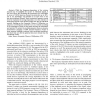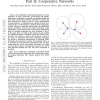495 search results - page 3 / 99 » Information theory of wideband communications |
ICASSP
2009
IEEE
14 years 2 months ago
2009
IEEE
The estimation of the impulse response (IR) of a propagation channel is necessary for a large number of acoustic applications: underwater communication, detection and localization...
GLOBECOM
2007
IEEE
14 years 1 months ago
2007
IEEE
— While the frequency-dependence of the wireless channel may be negligible for narrow to wideband signals, it has been shown that modeling this dependence for bandwidths in exces...
CORR
2010
Springer
13 years 7 months ago
2010
Springer
The availability of positional information is of great importance in many commercial, governmental, and military applications. Localization is commonly accomplished through the use...
CORR
2011
Springer
13 years 2 months ago
2011
Springer
Compressive sensing (CS) exploits the sparsity present in many common signals to reduce the number of measurements needed for digital acquisition. With this reduction would come, ...
CHES
1999
Springer
13 years 11 months ago
1999
Springer
The strength of a cryptographic function depends on the amount of entropy in the cryptovariables that are used as keys. Using a large key length with a strong algorithm is false co...


